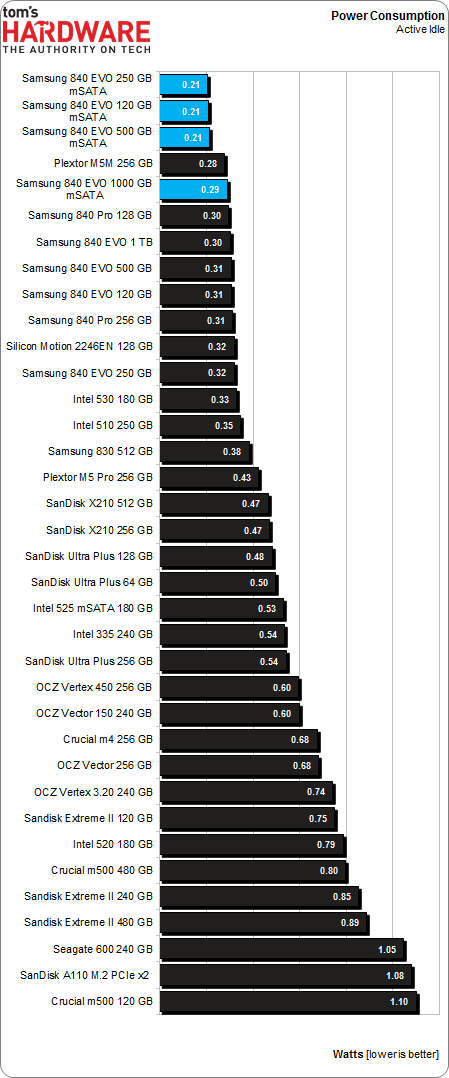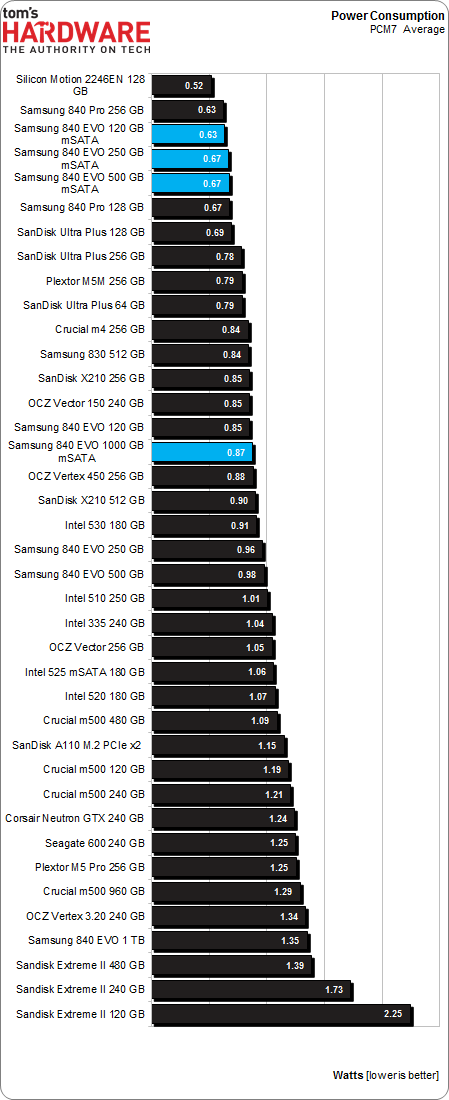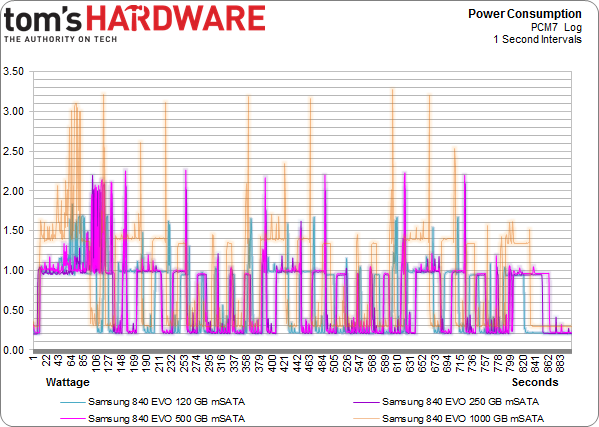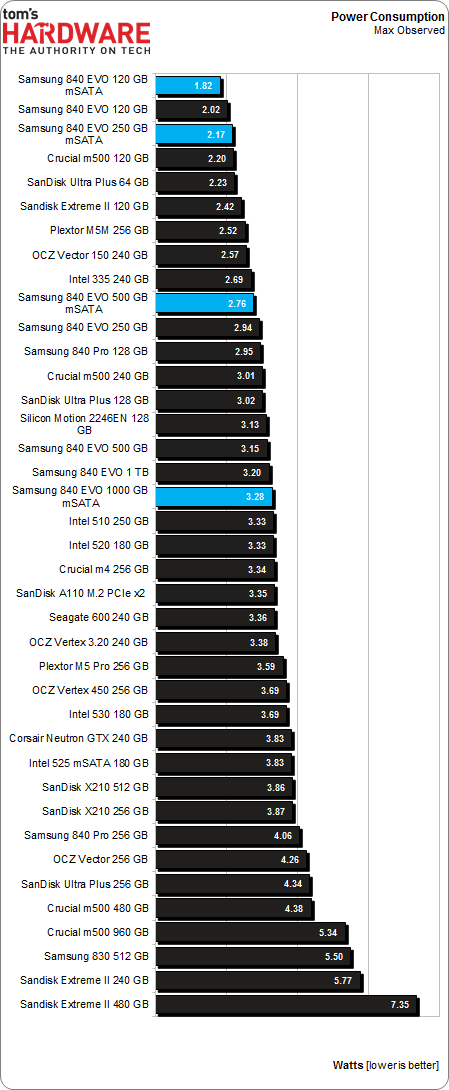Samsung 840 EVO mSATA Review: 120, 250, 500, And 1000 GB, Tested
Once upon a time, adopting mSATA-based storage meant compromising capacity and performance. With its 840 EVO, Samsung gives you access to as much as 1000 GB at incredibly fast speeds. The company even manages attractive pricing to keep mSATA competitive.
Results: Power Consumption
Idle Power Consumption
Idle consumption is the most important power metric for consumer and client SSDs. After all, solid-state drives complete host commands quickly, and then drop back down to idle. Aside from the occasional background garbage collection, a modern SSD spends most of its life doing very little. Enterprise-oriented drives are more frequently used at full tilt, making their idle power numbers less relevant. But this just isn't the case on the desktop, where the demands of client and consumer computing leave most SSDs sitting on their hands for long stretches of time.
Active idle power numbers are critical, especially when it comes to their impact on mobile platforms. Idle means different things on different systems, though. Pretty much every drive we're testing is capable of one or more low-power states, up to and including DevSleep. That last feature is a part of the SATA 3.2 host specification. And while it requires a capable SSD and a compatible platform, enabling it takes power consumption down to a very small number.
Samsung's newest drives really throw down the gauntlet when it comes to idle power measurements. The mSATA-based SSDs are thriftiest of all. Sure, the 1000 GB model does use almost 50% more power at idle than the three lower capacities, but that's still less than three-tenths of a watt. Each of the smaller drives manage .21 W at active idle.
PCMark 7 Average Power Consumption
If we log power consumption through a workload, even a relatively heavy one, we see that average use is still pretty close to the idle numbers. Maximum power may spike fiercely, but the usage seen during a PCMark 7 run is pretty light. You can see the drives fall back down to the idle "floor" between peaks of varying intensity.
Our average PCMark 7 power numbers tell a similar story, with the 1000 GB drive using significantly more power than the 120, 250, and 500 GB models. The log data shows what's happening in far greater detail. Behold!
See? The three smaller units are exceedingly similar, though with higher corresponding peak figures. The 1000 GB demonstrates significantly different characteristics, with considerably higher max use. Even when it comes off the peaks, though, it's still using more juice than the rest of the field.
Get Tom's Hardware's best news and in-depth reviews, straight to your inbox.
As we already know, idle power is much higher comparatively, so this all makes sense. Whatever Samsung had to do to make the 1000 GB mSATA-based model possible, there's clearly something unique going on with it.
Maximum Observed Power Consumption
Triple-level cell NAND requires more power than two-bit-per-cell flash. And yet, the two top spots in this chart are dominated by Samsung's 120 GB 840 EVO in 2.5" and mSATA trim. The 1000 GB version lands mid-pack, which is still quite good for a massive flash-based repository larger than the 120, 250, and 500 GB models put together.
Current page: Results: Power Consumption
Prev Page Results: File Copy Performance With Robocopy Next Page TRIM Testing: How Much Does The 840 EVO Benefit?-
blackmagnum Maybe it's time to upgrade the HD of an old working notebook to SSD! But will a Core2Duo processor bottleneck a SSD?Reply -
jrharbort @blackmagnum: You don't have to worry about your processor being a bottleneck, but rather, your system's SATA interface. It is highly doubtful that your Core 2-based notebook (much like my own) has an m-sata slot, and the 2.5" bay for a HDD would have a SATAII port, not SATAIII. So the overall max read/write rates would be cut in half. But to answer your question in another way, tom's posted an article almost a year ago on the subject of upgrading older systems with an SSD: http://www.tomshardware.com/reviews/ssd-upgrade-sata-3gbps,3469.htmlReply -
spookyman @blackmagnum: You be glad to upgrade your hard drive to a SSD drive. Did it for my goddaughter's after she had a hard drive crash and it runs a lot faster then before.Reply -
JohnnyLucky Interesting article. It coincides with the current shift from desktop pc's to mobile pc's.Reply -
pyro226 "The latest version offers RAPID support to non-EVO drives like the 840 Pro."Got my hopes up there. The standard 840 series SSDs are NOT supported. The article didn't explicitly state they were, but what other drives (aside from the 840 Pro and EVO) have Rapid support? Perhaps "The latest version offers RAPID support to both EVO and 840 Pro SSDs." would be more accurate.Reply -
LordConrad "This company has a track record of disrupting the markets it enters; now that it's focusing attention on smaller form factors with enthusiast-class hardware, it's only a matter of time before we start seeing M.2-based offerings as well."This is mainstream hardware, I don't know any enthusiats who will settle for drives with TLC NAND.Reply -
lowguppy It is nice to see these finally available. I've been watching the Crucial m500 mSATA drive for a while, and the 480gb version frequently falls under $300 on NewEgg, which is competitive with 2.5" SSDs.Reply -
RedJaron Reply
"Enthusiast" to me doesn't automatically mean getting the fastest, biggest, bestest, craziest parts regardless of price. It also means people who put a lot more thought into their systems and thoroughly weigh all their options. MLC, TLC, or not, the fact remains that the EVO is a fast, reliable drive for a good price.12750948 said:This is mainstream hardware, I don't know any enthusiats who will settle for drives with TLC NAND.
Your argument sounds similar to, "I don't know any enthusiasts who will settle for LGA 1150 instead of LGA 2011," or "I don't know any enthusiasts that would settle for a non-K CPU."



